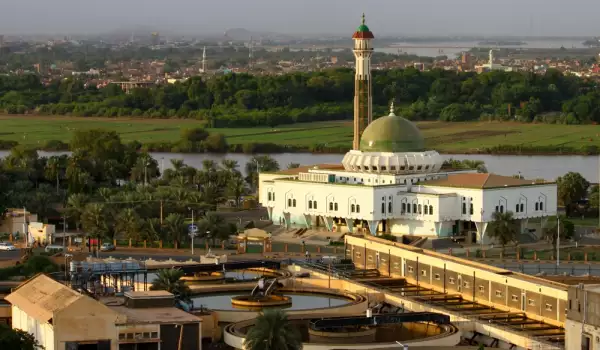Khartoum

Khartoum is the capital of Sudan. It is located in the eastern part of the country and is the center of the province of Al-Khartoum. Khartoum is located at the confluence of the White Nile, leading back to Lake Victoria and the Blue Nile, which starts from Lake Tana.
In the capital of Sudan today are about 2 208 000 people, and with the agglomeration formed by it and Omdurman to the west and Khartoum North / al-Khartūm Bahrī. The total inhabitants are around 8, 363, 915 people. This agglomeration is the fourth most populous in Africa.
The name comes from Khartoum's Arab "Al-kartoūm", which literally translates as "elephant trunk". Perhaps this name comes from the local narrow strip of land that was formed by Blue and White Nile. Khartoum was founded in 1820 as a military camp of the Egyptians.
In 1885 the town was destroyed and 13 years later it was restored by the British, when the Grand Master, Captain JA Gran draws locals for land in 1863.
Trade of saffron and butter, used as a fuel, is widely spread at this time in Sudan. After the attack on the old commercial center Shandy, Sudan’s trade is concentrated in Khartoum, with the result that here takes place almost all exchange of ivory, rubber, ostrich feathers and slaves from Central Africa to the Red Sea.
Later in the 70s and 80s of the 20th century in Khartoum sook shelter hundreds of thousands of refugees from Uganda, Ethiopia and Chad. Many of them settled in the outskirts of town.
Today, Khartoum is considered a cosmopolitan city with an exotic and unfamiliar culture. Here is the largest airport in Sudan, and the town is the administrative, economic and commercial center of the whole Sudan. While there are few paved streets, the center of Khartoum, however, is well planned with streets, trees, among which are many historical and cultural monuments.
Old city Khartoum is located exactly where the two main branches of the Nile merge. The view is very beautiful, consisting of many green islands. A pleasant trip along the water is taking a ferry across the island of Tuti, which is located in the middle of the merger of the two rivers and offers an exciting experience among the greenery in the middle of the river.
This mosque Shaheed is here and with a short trip along the river, the capital of Sudan- Omdurman can be reached. Major attraction for tourists are the dervishes who, through special dances and songs enter a trance. Sometimes you can see how the subject of the delirium foams from the mouth.
Interesting places to visit in this part of Khartoum is the Omdurman market where they still trade in ivory. Here one can buy a variety of handmade jewelry, leopard-skin slippers, spices, etc.
One of the landmarks of Khartoum is called the Moroccan bath. It is located in the north of Khartoum and has private, but also common steam rooms. This bathroom is only the preserve of women, as women are under the painstaking care of the many creams, herbs, perfumes, which release dead skin.
The townspeople were very hospitable and do not be surprised if you are being permanently invite home to dinner. You can accept the invitation only if in the day you have gone through the largest museum in Khartoum and throughout Sudan - National Museum of Sudan. It was opened in 1971 and tells the story of Khartoum.








